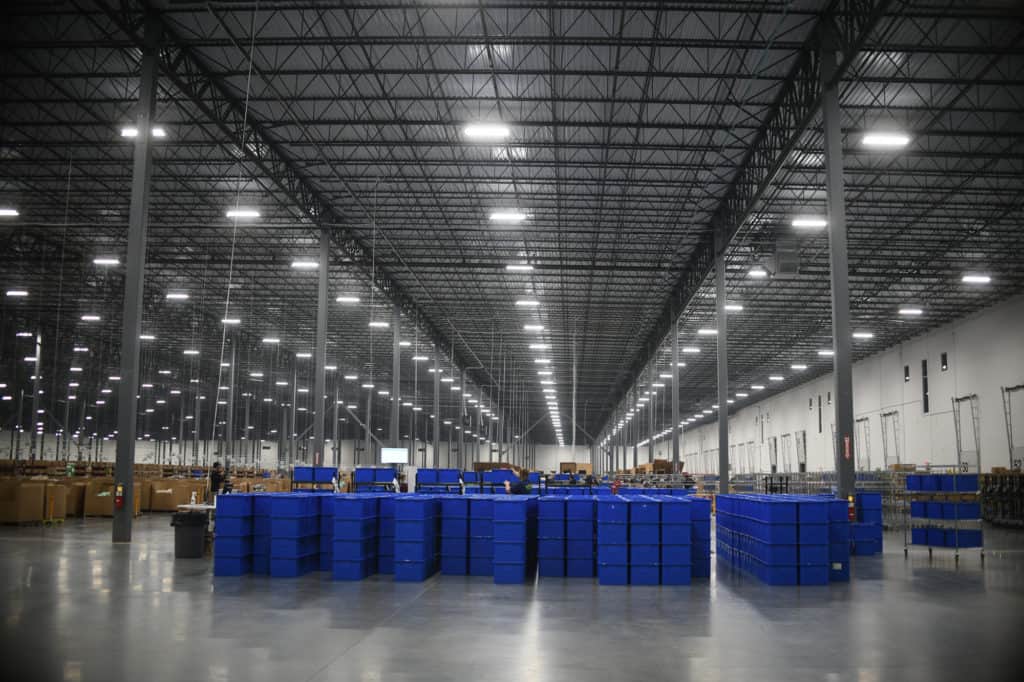Every warehouse manager feels pressure to operate their facility at top capacity with low overhead. It’s often difficult to keep up with the latest trends due to the rapid changes being made to the industry by advances in technology. Failing to stay on top of warehouse management best practices puts your business at risk of getting left behind by your competition. Following current best practices has become even more important in the face of global supply chain disruptions caused by the COVID-19 pandemic.
We’ve provided this handy guide full of insights from those working in or familiar with warehouse management. Use it to find ways to innovate and improve your own warehouse operations or organizations with management examples.
We made sure to touch on everything from big data to effective uses of your warehouse space and best practices in inventory management. Choose a category to jump to warehouse management tips in a particular section:
- Technology and innovation
- Organizing inventory
- Warehouse utilization and efficiency
- Data analysis
- Best practices during the COVID-19 pandemic
- Gearing up for a post-COVID-19 world
Technology and innovation
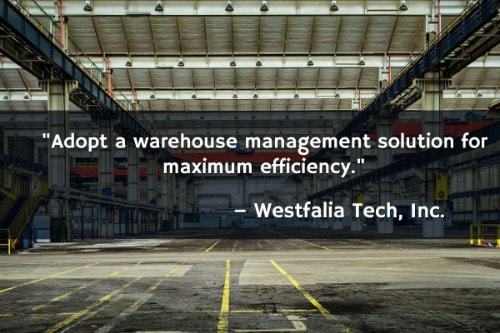
1. Invest in a warehouse management system. “Adopt a warehouse management solution for maximum efficiency. A good warehouse management solution will consolidate orders so that you can minimize travel time during picking, increasing efficiency and throughput. It can integrate with your ERP or inventory management system so that your inventory stays in sync — increasing accuracy, reducing costs and improving customer satisfaction.” — Top 11 Warehouse Operations Best Practices, Westfalia Tech, Inc.; Twitter: @WestfaliaUSA
2. Improve efficiency by eliminating paper processes. “Warehouse technology has changed data entry processes, enabling data to be entered directly into digital storage and reducing the scope for errors caused by readability problems, lost paperwork and other issues arising from the translation of handwritten data into electronic bits and bytes.
“By removing the need for paper processes, warehouse technology has reduced operating costs (because companies don’t have to spend money on paper, related stationary or the supply of pre-printed documents). It has also contributed to sustainability, since warehouse operations now place less demand on forestry resources.” — The Past, Present, and Future of Technology in the Warehouse, Logistics Bureau; Twitter: @LogisticsBureau

3. Use wireless devices to improve communication. “Communication by email is a great communication tool; however, when it comes to time-sensitive communication, direct contact is much more efficient. Make use of one or more of the wireless technologies available to increase your productivity. A key in selecting technologies is that they must integrate and work together. Whether you choose to communicate through radio, laptop or smartphone, invest in a system that all departments can use consistently. This will give your warehouse real-time efficiency and improve productivity.” — Jerry Matos, 5 Ways to use Technology to Run a More Productive Warehouse, 3DS Delmia/Apriso; Twitter: @3DSdelmia
4. Automate your return management. “Returns are an inevitable part of operating a business. In fact, about 30 percent of all online orders are returned and they can hurt your bottom line if not handled correctly. That’s reason enough to implement a return processing system.
“A return management system tracks and stores data for you to provide insight on who is returning what, why the item is being returned and the associated costs. This system also issues the refund payment for your customer. Overall, the collected information helps maintain inventory control and grasp your customers’ buying habits and preferences.” — Brandon Barborka, Must-Have Technologies for Your Warehouse Operation, Staff Management; Twitter: @staffmanagement
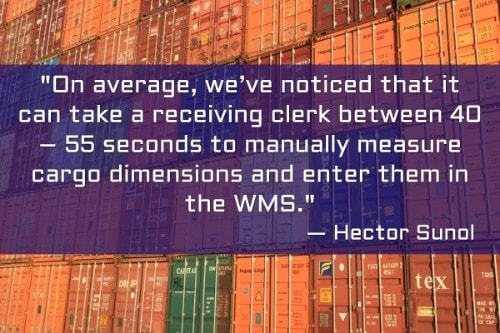
5. Eliminate manual pallet and box dimensioning. “Pallet and box dimensioning can be very time consuming. On average, we’ve noticed that it can take a receiving clerk between 40 – 55 seconds to manually measure cargo dimensions and enter them in the WMS. All this without considering the likelihood of errors when done manually.
“Dimension systems measure pallets and/or boxes, putting the dimensions automatically into the warehouse receipt. Some can even be integrated with the scale to allow you to capture dimensions and weight automatically into the receipt.” — Hector Sunol, 3 Technologies to Improve Warehouse Efficiency, Cyzerg Warehouse Technology; Twitter: @CyzergLLC
6. Store your data in the cloud. “Keeping records on paper & files is a much tedious task causing wastage of space. For the same, all warehousing data and reports can be saved digitally on a remote location server or cloud-based storage. It enables users to create a backup related to inventory, sales, billing, etc. which can be used for reference at any point in time in future.” – Five Must Have Technologies For A Smarter Warehouse, Holisol Logistics; Twitter: @holisollogistic

7. Use robotics to improve efficiency. “New robotics technology has become one of the most sought after technologies for warehouse management. Leading-edge manufacturers are partnering with providers of warehouse management systems to create customized software and smart robots that help manage the movement, storage and sorting of warehouse inventory.
“Investing in warehouse robotics technology will highly benefit you. With increasing order volumes, numerous products to navigate, highly personalized order packing and faster shipping requirements, robotics solutions will help you effectively respond to volume growth and perform more tasks with less labor and at a lower cost.” — Adam Robinson, 7 Innovative Warehouse Management Technologies to Adopt, Cerasis; Twitter: @Cerasis
8. Check the potential ROI before adopting any new technology. “Above all, new technology should decrease your costs overtime and improve your opportunity to earn higher profits. One of the best ways to determine cost efficiency is to analyze your profitability by customer account.
“If your analysis concludes that a certain technology could help reduce current costs to serve your customers, then it may be worthwhile to invest. Once the cost of the software has amortized, your ROI would increase exponentially. It would be like giving yourself a raise — without increasing the amounts you charge your customers.” — 5 Ways to Assess Your Warehouse Technology Needs, Supply Chain 24/7; Twitter: @SupplyChain247

9. Look into incorporating AI solutions. “AI carries great potential to revolutionize supply chain processes. The ability to apply AI to enhance, and even automate, decision making, reinvent business models and ecosystems and remake the customer experience could make many other emerging technology trends redundant.
“However, although current AI solutions can find patterns and predict future scenarios, they still lack decision-making abilities. Combining pattern capabilities with more advanced prescriptive capabilities will therefore be critical to widespread supply chain uptake, enabling users to dedicate their skills to higher-order use cases such as strategic network design or capacity planning.” — Christy Pettey, Gartner Top 8 Supply Chain Technology Trends for 2018, Gartner, Inc; Twitter: @Gartner_inc
10. Focus on visibility. “Visibility in the distribution center helps all parts of the supply chain function as a single unit. Reports, dashboarding tools, key performance indicators and metrics, created and analyzed via big data and analytics, can help managers stay aligned with enterprise-wide and customer needs, fulfill more orders, and avoid disruptions or repercussions from violations of regulatory measures.” — Jason Rosing, What Warehouse Management Technology Is Necessary to Create a Best-in-Class Distribution Center?, Veridian; Twitter: @VeridianInfo

11. Consider blockchain technology for data security. “Blockchain and AI first certainly made their presence felt in the logistics industry this year. With the security and transparency blockchain offers, it offers an impenetrable way to store and share transactional data, while improving credibility with foolproof transactions.
“For example, if customer’s ID proof is available digitally through a blockchain structure, it cannot be fudged by him at the time of delivery. Similarly, it’s possible to map the unique blockchain-enabled registration number of every vehicle against the delivery job IDs. By 2021, as much as 25% of the large global companies will be piloting or using AI and blockchain-based automation in transactional procurement.” — Kushal Nahata, Trends That Will Revolutionize Logistics in 2018, Material Handling & Logistics Magazine; Twitter: @MHLeditor
12. Use drone technology for better oversight. “While you may think of drones as something futuristic or even Big-Brother-ish flying over and recording you, they are very helpful in the warehouse. Providing assistance with hard-to-reach areas, as well as reading tricky barcodes that might otherwise need a forklift, drones are becoming more common to the naked eye.” – Jennifer Clark, Warehouse Trends to Look For and the Technology to Implement, ScanSource; Twitter: @ScanSource

13. Think about supplying workers with more durable computer and mobile equipment. “Rugged mobile devices — handheld computers, tablets, scanners, imagers, thermal printers — will replace consumer-grade devices. Employers are discovering that the cost of replacing personal smartphones and tablets that last less than a year is too high. Plus, they need enterprise-grade features — like better data and network security, device management and data capture — that only purpose-built, commercial grade technology can deliver.” — Chelsea Khouri, Visibility in 2018: Trends in Manufacturing Technology, Informs, Inc; Twitter: @informsinc
14. Collect data on the go. “Recording data automatically can increase productivity and accuracy, and lower labor costs. Capturing real-time information using bar codes and radio frequency identification tags can get products off the dock quickly and reduce human issues typically caused by manual receiving, such as counting and data errors, from the tracking process. Automatic data collection also increases historical information, which allows managers to change product locations based on order consistency and picking difficulty.” — Bisk, Warehouse and Distribution Center Best Practices, Michigan State University Eli Broad College of Business; Twitter: @MSUBroadSchool
Organizing inventory
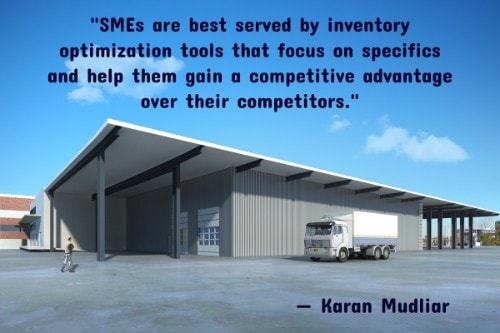
15. Leverage optimization tools in your processes. “SMEs are best served by inventory optimization tools that focus on specifics and help them gain a competitive advantage over their competitors. These tools help marketers and warehouse managers evaluate the concerned networks for the best policies and even the existing inadequacies.” — Karan Mudliar, How SME’s can improve their Inventory Management Process, Sungistix; Twitter: @Sungistix3PL
16. Keep up with your fixed and movable assets. “When companies think of warehouse tracking, they think primarily of movable tracking options, tracking the units and pallets that actually get moved around the warehouse and sent up the supply chain. This is only one part of the warehouse management process — do not forget the benefits that come with used fixed trackers, too! By tracking fixed warehouse assets, you are able to assign and manage destinations much more easily and arrange strategy protocols as needed without mass confusion. It is better to think of warehouse tracking in two different parts, one fixed and one movable.” — 7 Tips for Warehouse Inventory Management, Qstock Inventory; Twitter: @QStockInventory
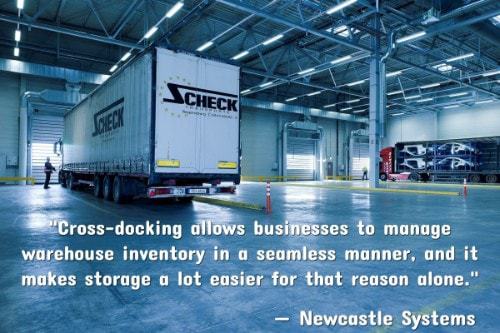
17. Save money with wave-picking and cross-docking. “Cross-docking allows businesses to manage warehouse inventory in a seamless manner, and it makes storage a lot easier for that reason alone. If you have a complex shipping system, you can opt for wave picking. If you adopt an advanced tracking method, you will find both cross docking and wave picking to save money and time.” — 7 Best Practices for Inventory Management for Warehouses, Newcastle Systems; @NewcastleSys
18. Use labels effectively to help with inventory location. “Implementing labeling to industry standards can have a measurable impact on your business in terms of time, labor, order fulfillment rates and errors. This can also enhance the morale of your warehouse workforce and reduce frustration and lost products. With today’s technology, labels are made to meet a wide variety of needs in the warehouse, from highly durable to temperature sensitive for cold storage warehouses. A relatively minor investment in labeling can help ensure that warehouse workers do not waste time, handle the correct product and fulfill orders in a timely manner.” — Inventory Management Tips: Optimizing Your Warehouse, Datex; Twitter: @Datexcorp

19. Make sure you’re doing the proper upkeep for your warehouse. “Inspect your operation regularly and review your warehouse’s organization — just because it was well-organized when you initially started, doesn’t mean that it meets your current standards.
“You’ll want to look for things like: is the stock located in a way that it allows your crew to easily and safely access it? Are the fasting moving SKUs located at between waist and shoulder height so that they can be quickly retrieved? Is there a designated area for damaged items, and are the damaged items being dealt with daily? Without regular upkeep, a well-organized warehouse can quickly become disorganized and difficult to navigate which can slow your pickers down and lead to safety hazards.” — Emilie Fritsch, Warehouse Inventory Management: 10 Tips You Need to Know, Skuvault; Twitter: @skuvault
20. Use forecasting in your budgetary planning. “Inventory forecasting is a crucial part of a business’s budgetary planning. Forecasting tools use historical sales data to intelligently predict future performance, which can be used to assess demand levels so inventory can be managed accordingly. These forecasting reports help ensure adequate resources are included in inventory. By using data algorithms and formulas, trends and patterns of sales can be tracked with impeccable accuracy.” — Joe Scioscia, 7 Tips For Better Inventory Management, Manufacturing Business Technology
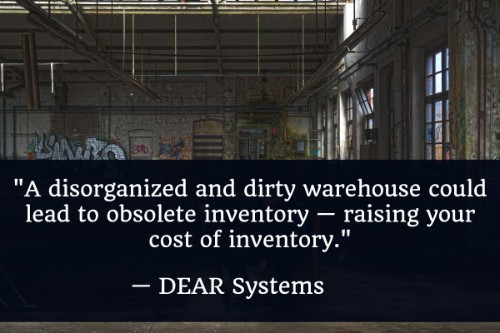
21. Clean your warehouse and inventory regularly. “The more clutter in your warehouse, the higher the likelihood of safety hazards and accidents, in addition to reduced productivity.
“More than that, a disorganized and dirty warehouse could lead to obsolete inventory — raising your cost of inventory.
“An orderly warehouse, on the other hand, will increase your efficiency and throughput, while potentially improving your lead times.” — 7 Warehouse Organization Tips That Will Increase Your Productivity Today, DEAR Systems; Twitter: @DearInventory
22. Do careful surveying and auditing of your inventory. “Typically, a company’s inventory that accounts for more than half of its working capital would get plenty of attention. However, in reality, only a few companies seem to really pay attention to their stockroom or warehouse, or the five processes that affect it (receiving, put-away, order picking, shipping and maintenance, where ‘maintenance’ represents the combination of cycle counting, consolidation and other processes that maintain the stockroom in good operating order).
“Use DMAIC: Define, Measure, Improve and Control. Also use PDCA: Plan, Do, Check and Act. Use a cross-functional team to solve problems.
“Make cycle counting and root cause analysis a central focus in your warehouse: put up a large chart and post accuracy percentages for everyone to see because inventory records accuracy affects ALL departments in the company.” — Charles Intrieri, Warehouse management: How to run a warehouse audit and survey, TradeGecko; Twitter: @tradegecko

23. Don’t ignore warning signs. “The easiest way to identify that you have too much — or the wrong inventory — is the amount of dust settled on the product in storage. If you see more than ½ inch of dust, then that’s likely a sign of obsolete inventory. However, there are other, more specific indicators that inventory management issues need to be addressed.
“If there are significant discrepancies between the book inventory and physical inventory, this is a direct indicator that there is a problem with inventory management. Another distinct indicator is when your warehouse staff is having trouble locating inventory on a timely basis — an issue that’s particularly critical when FIFO, batch/lot number or serial number controls are involved.” — Inventory Management 101: Time to revisit the principles, Logistics Management; @LogisticsMgmt
24. Keep unauthorized people off the warehouse floor. “No one should be in the warehouse area without a purpose and authorization. You only want people who know how the warehouse stock is organized to access the space. This helps eliminate the possibility of stock getting moved around without the knowledge of those who work in the warehouse.” — Reid Curley, 8 Tips for Maintaining Warehouse Stock Organization, Archon Interactive; Twitter: @ArchonWMS

25. Watch your inventory levels. “Keep an eye on your inventory levels to avoid overextending on slow-moving items or under buying your best sellers. Although inventory management systems will be crucial here, they must work in real-time to ensure goods coming in and out of the warehouse are recorded instantly. You also must keep an eye on your reports to ensure you only stock your best sellers and fade out your worst sellers.” — Justine Cross, 9 Inventory Management Tips to Get The Most Out of Your Warehouse, Technology Advice; Twitter: @Technology_Adv
26. Implement and enforce strong receipt and storage practices. “Even if the first two rules for inventory management are followed, the warehouse is only as efficient as its documented policies and procedures. For efficient inventory movement and accurate data recording it’s important to define all the processes within the warehouse. So how do you go about doing this?
“All process documentation should include procedures for physical interaction, material handling, safety guidelines and quality of reporting. These procedures should include step-by-step processes for the receipt and put away of the material. The documented procedures should detail how the inventory should be handled, checked and put into storage locations. The instructions also need to include how to handle damaged inventory — can it be reworked or does it need to be scrapped?” — Catherine Muir Ted Rohm, 6 Tips to Improve Inventory Accuracy, Technology Evaluation Centers; Twitter: @TECtweets

27. Organize your picking stations logically. “Optimizing picking efficiency and accuracy is best accomplished by rationalizing picking locations. When organizing your picking locations, ensure your products are kept separate, for example creating specific locations for each item of stock or SKU (Stock Keeping Unit). Typically, this is a picking bin in a bin location on a shelf or pallet space in the warehouse.
“One thing to take note of is that SKUs should not be mixed together in a single location. This will lead to errors in picking and checking. It is also less efficient if a picker has to search for the SKU in a mixed bin.” — Donavon Ng, 10 Tips For Better Warehouse Inventory Management, Sweet Technology, Inc; Twitter: @SweetTechInc
28. Put quality control processes in place. “Quality control is of utmost importance in any size business and should be implemented as early as possible. Having a process to ensure quality can be directly linked to customer satisfaction and business growth.
“Starting quality control procedures can be as easy as making a checklist that provides all procedures employees need to follow when checking the goods they receive.” — Brad Vinson, 6 Inventory Management Best Practices, Wasp Barcode; Twitter: @WaspBarcode
Warehouse utilization and efficiency

29. Plan Our Your Warehouse Space. “Every inch of the warehouse needs to be planned to maximize storage space. It is one of the best warehouse management best practices that can be implemented without much cost. The space has to be organized in such a way that allows for quick and smooth carrying of goods. There must be adequate space for forklifts and weight carrying machines to move around. If the bins are properly planned and marked for, it will help avoid confusion and stocking of goods at inappropriate places.” — 9 Impactful Warehouse Management Tips To Improve Inventory Control, Contalog; Twitter: @ContalogApp
30. Put strict safety measures in place. “Don’t make your warehouse an unsafe place for your employees. If your staff isn’t trained properly, you will have numerous accidents and high injury rates. Ensure that only the well-trained and experienced employees operate heavy duty equipment such as forklifts. Mark the safety protocols in the warehouse, such as indicating a safe distance from danger zones.” — Kevin Hill, 7 Warehouse Management Tips To Improve Inventory Control, Procurious; Twitter: @procurious_
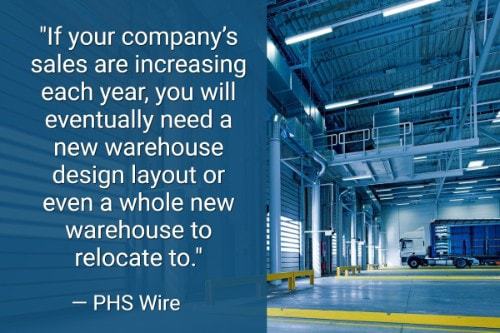
31. Perform continuous analysis of your current warehouse design. “No matter how organized you may be, if your company’s sales are increasing each year, you will eventually need a new warehouse design layout or even a whole new warehouse to relocate to. It is recommended that this space evaluation takes place about every three to five years, depending on the rate at which your company notably increases sales.” — 7 Ways to Organize Your Warehouse, PHS Wire
32. Match slot sizes to products. “Match the size and sales of the item to the right-sized pick slot to maximize the utilization of the picking slot cube. Having various sizes of picking slots can facilitate this process. The same logic applies to locations where you store reserve or overstocks. In forward picking, keep 4-7 days of sales by SKU to reduce replenishment.” — Brian Barry, 15 Ways to Improve Warehouse Space Utilization, Multichannel Merchant; Twitter: @mcmerchant
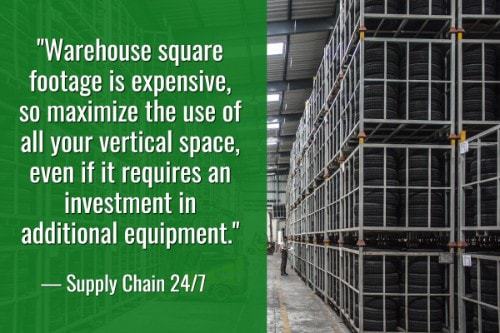
33. Use all your space effectively. “Warehouse square footage is expensive, so maximize the use of all your vertical space, even if it requires an investment in additional equipment. You will reduce operational costs, inventory carrying costs and increase the efficiency of picking and packing operations.” — 11 Warehouse Operations Best Practices, Supply Chain 24/7; Twitter: @SupplyChain247
34. Put safeguards in place during shipping. “A company should ensure that the inventory being shipped out of the warehouse facility is secured until it is loaded onto the carrier’s truck. The warehousing manager should consider a risk-based approach to shipping dock procedures, put more security on items that are of higher value or are easier to steal.” — Justin Johnson, Best Practices in Warehouse Operations, Houston Chronicle; Twitter: @HoustonChron
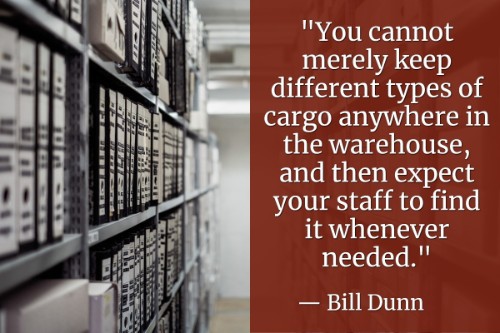
35. Incorporate bin locators into your storage system. “You cannot merely keep different types of cargo anywhere in the warehouse, and then expect your staff to find it whenever needed. To organize your warehouse efficiently, you can bin locate your cargos. It refers to a designated inventory storage location system, where you mark all the rows, columns and racks. When you keep a particular product in one of these locations, the specific row, column and rack become the bin number for that type of product. The format of the bin number is entirely your decision.” — Bill Dunn, Top 5 Tips To Optimize Your Warehouse Storage System, Cerasis; Twitter: @Cerasis
36. Track your storage and space capacity. “In efforts to monitor capacity and space availability, warehouses can use barcode scanners and bin locations to track used/unused space across warehouse zones. This solution is currently available across most warehouse management systems (WMS). However, this system is prone to human errors as it relies on the warehouse clerk to scan the bin location and cargo every time he/she performs a put-away or pick task.
“Another approach is through the use of RFIDs to automatically record tasks without any human intervention. Although this solution still being perfected and tested, the use of RFIDs combined with more advanced solutions such as sensors will be part of an ecosystem of technologies that will deliver real-time capacity and space tracking capabilities within the warehouse.” — Hector Sunol, Warehouse Operations: Optimizing the Put-Away Process, Cyzerg Warehouse Technology; Twitter: @CyzergLLC

37. Make sure everything can be seen. “While using all available space is key, it’s imperative that you use it wisely. One of the biggest mistakes we see is items getting ‘lost’ because they’re trapped behind other items. Sometimes, this means it takes workers longer to find what they need. In other cases, they never find the item they’re searching you and you needlessly order more of something you already have. Keep items visible to avoid this problem.” — Denis Benden, 7 Ways to Improve Your Warehouse Space Utilization, Benco Industrial Equipment
38. Keep worker stations organized. “Organizing workstations improves productivity because workers do not have to search for tools or equipment. Use the ‘5S’ method from lean manufacturing to ensure your workstations are as organized as possible. It consists of: Sort; Set in order; Shine; Standardize and Sustain — all techniques designed to keep clutter at bay, reduce errors and improve safety and organization.” — Denny Hammack, Five simple ways to improve warehouse efficiency, Supply Management Magazine; Twitter: @supplymgmt

39. Inventory should be accessible and easily handled. “It is very important to keep the regularly required units at a more convenient location and ensuring that the items are easy to handle. It’s one of the best warehouse practices that heavier goods are stored at the bottom of the shelf and lighter loads above the heavier goods. This makes it easier as well as reduces risks of accidents.” — Transform Operations With Best Warehousing Practices, Holisol Logistics; @HolisolLogistic
40. Replenishment should be a priority. “Every team needs someone ready to step in, which is why your warehouse should prioritize replenishment. Prioritize it to reduce short picks and to reduce overflow in the receiving area. Instead of leaving new product at the receiving door, find times for your operation to fit replenishment in throughout the day. This will eliminate sending out orders which are short a part or two, when in fact you had those parts in your facility the entire time!” — Chelsea Tarr, 55 Warehouse & Distribution Practices, Kardex Remstar; Twitter: @KardexRemstar
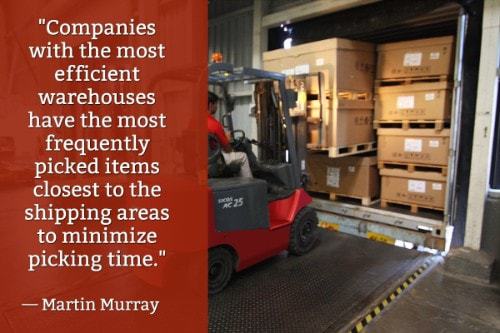
41. Put high-volume items close to shipping areas. “Companies with the most efficient warehouses have the most frequently picked items closest to the shipping areas to minimize picking time. These companies achieve their competitive advantage by constantly reviewing their sales data to ensure that the items stored close to the shipping area are still the most frequently picked.” — Martin Murray, 5 Warehouse Best Practices to Lower Picking Time, The Balance Small Business; Twitter: @thebalance
42. Enforce requirements for business partners and customers. “For the warehouse receiving process to run efficiently you’ll need to establish and enforce receiving requirements for suppliers, shippers and/or carriers. The objective is for them to present the cargo in a way that is quick and easy to process.” — Hector Sunol, Warehouse Operations: Optimizing the Receiving Process, Cyzerg Warehouse Technology; Twitter: @CyzergLLC

43. Keep product data information up to date. “All warehousing software runs on data, therefore product and storage location data must be kept current and accurate. Best-practice companies maintain all information on a single system of record and keep it current and accurate. Product data should include all product characteristics including cube data, lot/serial-number information and special requirements so that product can be directed to special storage areas.” — Kate Vitasek, Storage and Inventory Control Best Practices, Multichannel Merchant; Twitter: @mcmerchant
Data analysis
44. Use data to manage your supply levels. “Applications for analysis of unstructured data has already been found in inventory management, forecasting and transportation logistics. In warehouses, digital cameras are routinely used to monitor stock levels and the messy, unstructured data provides alerts when restocking is needed.
“Forecasting takes this a step further — the same camera data can be fed through machine learning algorithms to teach an intelligent stock management system to predict when a resupply will be needed. Eventually, the theory is, warehouses and distribution centers will effectively run themselves with very little need for human interaction.” — Bernard Marr, How Big Data And Analytics Are Transforming Supply Chain Management, Forbes; Twitter: @Forbes
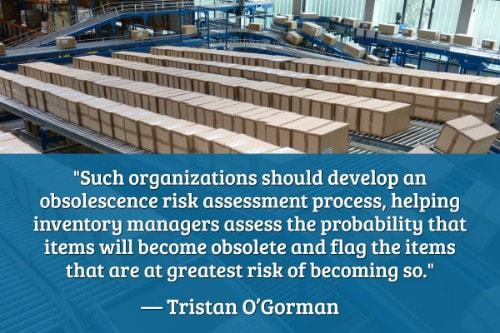
45. Help identify potentially obsolete inventory. “To manage obsolescence proactively, organizations must be able to answer questions such as the following: How can we anticipate obsolescence? What contingency plans have we in place? What are our most important needs? Should we maintain items, or replace them? How do we ensure safety?
“Such organizations should develop an obsolescence risk assessment process, helping inventory managers assess the probability that items will become obsolete and flag the items that are at greatest risk of becoming so. To augment the process, inventory managers can use analytics to identify already obsolete items, identify items that the organization can afford to manage reactively and reduce the manual effort involved in computing the probability of obsolescence.” — Tristan O’Gorman, 5 inventory analytics best practices to achieve inventory optimization, IBM Big Data & Analytics Hub; Twitter: @IBMData
46. Invest in big data training. “It’s important for organizations to always stay informed about the new resources that are quickly becoming available. We recommend investing in training programs and ongoing education initiatives. Try working with industry organizations like the Council of Supply Chain Management Professionals (CSCMP) or paying for your employees to attend annual educational events that will expose them to the latest solutions that will help your organization run efficiently.” — Larry Basel, Leveraging Big Data As Supply Chain Management Changes, Manufacturing.net; Twitter: @MnetNews
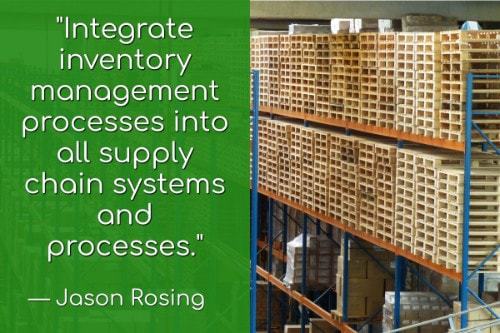
47. Integrate inventory management into supply chain processes. “Integrate inventory management processes into all supply chain systems and processes. Supply chain managers can quickly review operations and act on data. However, the day-to-day decisions of warehouse management may need split-second action, so warehouse managers using KPIs may still make impulsive decisions. Therefore, any decision made should always include a review of KPIs as soon as possible to ensure the right decision was enacted.” — Jason Rosing, Supply Chain Inventory Optimization – Beyond the Analytics, Cerasis; Twitter: @Cerasis
48. Use data analysis to improve overall company performance. “Data and analytics derived from your daily supply chain operations can give your business insight into what areas are performing above expectations, at acceptable levels and those that are underperforming. Once any pain points have been identified, warehouse operators and other key players can develop new supply chain strategies to increase operational effectiveness, reduce costs and improve labor productivity.”— The Importance of Supply Chain Data, Reporting & Analytics in Decision Making, Datex Corporation; Twitter: @Datexcorp

49. Incorporate external benchmark tools for more accurate insights. “Many suppliers and manufacturers may have existing, internal analytics tools, but using these tools for benchmarking processes may be ill-fated. Internal tools have a way of making the company appear better than it truly is. As a result, an external benchmarking tool, explains Olga Rissin of CHAINalytics, offers the benefits of reducing internal spend and accessing outside data, which further drives competitive advantage and lower spend in managing the procurement supply chain.” — Kevin Jessop, 10 Key Logistics & Procurement Supply Chain Practices to Know and Master to Reduce Spend, Cerasis; Twitter: @Cerasis
50. Gain more visibility from data analysis. “Instead of an afterthought, supply chain managers will look at visibility from a proactive standpoint. They will develop new systems and processes to gain greater visibility, and this will require the hiring of data scientists as well. The discussion of hiring practices in 2018 is incomplete without touching on the skills gap, so supply chain managers must effectively transform hiring practices to include data scientists and compliance experts that will work together to drive overall compliance within an organization.” – Adam Robinson, The supply chain technologies that will solidify the digital supply chain in 2018, Digital Supply Chain; Twitter: @SupplyChainD
Best practices during the COVID-19 pandemic
Right now, it’s still too early to determine the full impact of COVID-19 on economies, businesses and supply chains. Nevertheless, 75% of businesses report severe disruption of their supply chain networks. As a result, 16% of businesses experiencing severe disruption have had to adjust their revenue targets downward. It’s unclear just how long a full economic recovery will take. McKinsey & Company analyzed nine possible recovery scenarios — largely dependent on the strength and success of the public health response – and estimates that the U.S. could begin to see economic recovery as soon as Q3 2020 or as late as Q1 2023. “The economic impact in the US, however, could exceed anything experienced since the end of World War II,” says Laura Oliver in a March 2020 article published at the World Economic Forum.
With the impact of the coronavirus pandemic reverberating off supply chains all around the world, it’s essential that companies adjust operations to minimize these disruptions. As such, let’s review some top warehousing best practices during the COVID-19 pandemic.
1. Stay safe
The safety of employees should be your most important objective during this period. Warehouse managers should train employees for the new normal, develop safe warehouse operating procedures and ensure strict adherence. The usual safety precautions include:
- Checking employees’ temperatures when entering the facility
- Frequently disinfecting equipment and high-contact areas (possibly every two hours)
- Wearing face masks
- Maintaining the minimum safety perimeter between employees (at least six feet)
- Avoiding face touching
- Using two-way radios to aid communication (especially in busy distribution centers with constant noise from machinery)
While the Centers for Disease Control and Prevention (CDC) isn’t completely certain that the virus can spread through packages, employees should use gloves when handling packages and wash/sanitize their hands afterward.
2. Diversify your supplier base
“We’re seeing that organizations who diversified their supplier base after experiencing tariff impacts are potentially more equipped to address the effects of COVID-19 on their supply chains. Companies with less flexible supply chains are left without options: more than 44% of respondents reported that they didn’t have a plan in place to handle a supply disruption with China, and more than half of that 44% are reporting current disruptions,” says Thomas Derry in an article published at the Institute for Supply Management® (ISM®) in April 2020.
3. Adjust operations in line with the surge in online shopping
The pandemic has created a massive shift in consumers’ purchasing behavior. Aside from a sharp decline in sales of luxury items, there has been an unprecedented rise in the volume of online shoppers, especially in groceries, household supplies like hand soap, disinfecting wipes and other essentials. This shift is creating challenges and complexities for warehouses with insufficient capacity, inventory and technology to deal with the upsurge in orders from online channels. Savvy warehouse managers should move swiftly and leverage robotics, automated systems and order picking processes best suited for fulfilling orders from online shoppers.
4. Evaluate product and customer priorities
Now more than ever, companies need to decide on priorities in view of anticipated inventory shortages. You must decide how orders will be fulfilled when (not if) products become scarce. Do you fulfill customers’ orders as is, based on strategic importance or in proportion to expected volumes (fair share)?
Also, you must communicate with key customers to discuss supply challenges and come up with alternative arrangements to fulfill contractual commitments. Doing so will help you avoid customer attrition and minimize associated losses.
Gearing up for a post-COVID-19 world
Before the pandemic, many organizations were unaware of how global shocks could affect their supply chain relationships. Thankfully, the lessons learned during this period will give birth to a new, agile and more resilient supply chain model — one that will leverage new and emerging technologies to improve end-to-end visibility of the entire supply chain and warehouse operations. Let’s take a look at best practices for optimizing warehouse operations in a post-COVID-19 world.
1. Adjust for longer lead times
On average, lead times have more than doubled from December 2019 figures. 57% of respondents to an Institute for Supply Management survey report longer lead times when sourcing tier-1 components from China, while 62% experienced delays receiving orders from China. Supply chain managers will have to adjust warehousing, order fulfillment and replenishment activities to account for increased lead times.
2. Seek alternative logistics solutions
The pandemic has brought about a significant decline in the volume and capacity of air freight as well as significant port congestion, coupled with the long-running shortage of truck drivers. Once the pandemic runs its course, there will be a significant backlog in logistics which will take time to resolve before shipping operations gradually return to normal.
Savvy supply chain managers should seek alternative routes and methods of shipping to ensure efficient last-mile delivery and prevent adverse impacts on replenishment activities. This strategy includes securing as much as capacity as possible from logistics partners.
3. Explore a new supply chain model
Modern supply chains are highly sophisticated networks, interlinking several components (people, processes, technology and logistics) and spanning across the globe. However, this global nature means there are more potential points of failure. Essentially, a global supply chain is more vulnerable to risk and thus, less able to absorb disruptions and delays.
Companies must shift their focus from optimizing supply chains (through minimizing operations costs and maximizing asset utilization) to building digital supply networks (DSNs), designed to reconfigure themselves in real-time to mitigate the impact of anticipated service disruptions. This shift requires the total breakdown of functional silos that exist within most organizations and building next-level interconnectedness to enable optimization, agility, responsiveness, collaboration and end-to-end visibility across the supply chain.
4. Get ready for the rebound
No pandemic lasts forever. While there have been extensive supply chain disruptions, the worst may very well be behind us. What separates companies that will thrive post-crisis from those that don’t is how well they prepare for the rebound.
Moving faster than the competition will enable you to capture a large chunk of the pent-up demand, secure new customers and solidify your relationship with existing customers. Implementing the best practices outlined above puts you in a position to react with agility to volatile conditions post-crisis before markets and operations gradually return to any semblance of normalcy.
Interested in more? Let’s discuss the solution that’s right for you. Contact us today.

